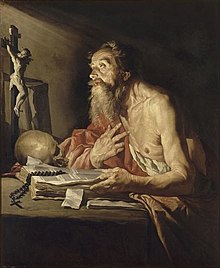
Back Hieronimus van Stridon Afrikaans جيروم Arabic جيروم ARZ Xerónimu d'Estridón AST Stridonlu İyeronim Azerbaijani Hieronymus BAR Еранім Стрыдонскі Byelorussian Геранім Стрыдонскі BE-X-OLD Йероним Блажени Bulgarian Hieronimos Breton
| Part of a series on |
| Catholic philosophy |
|---|
   |
Jerome (/dʒəˈroʊm/; Latin: Eusebius Sophronius Hieronymus; ‹See Tfd›Greek: Εὐσέβιος Σωφρόνιος Ἱερώνυμος; c. 342–347 – 30 September 420), also known as Jerome of Stridon, was an early Christian priest, confessor, theologian, translator, and historian; he is commonly known as Saint Jerome.
He is best known for his translation of the Bible into Latin (the translation that became known as the Vulgate) and his commentaries on the whole Bible. Jerome attempted to create a translation of the Old Testament based on a Hebrew version, rather than the Septuagint, as prior Latin Bible translations had done. His list of writings is extensive. In addition to his biblical works, he wrote polemical and historical essays, always from a theologian's perspective.[3]
Jerome was known for his teachings on Christian moral life, especially those in cosmopolitan centers such as Rome. He often focused on women's lives and identified how a woman devoted to Jesus should live her life. This focus stemmed from his close patron relationships with several prominent female ascetics who were members of affluent senatorial families.[4]
In addition, his works are a crucial source of information on the pronunciation of the Hebrew language in Byzantine Palestine.[5]
Due to his work, Jerome is recognized as a saint and Doctor of the Church by the Catholic Church, and as a saint in the Eastern Orthodox Church,[a] the Lutheran Church, and the Anglican Communion. His feast day is 30 September (Gregorian calendar).
- ^ Kurian & Smith 2010, p. 389: Jerome ("Hieronymus" in Latin), was born into a Christian family in Stridon, modern-day Strigova in northern Croatia
- ^ "St. Jerome (Christian scholar)". Britannica Encyclopedia. 2 February 2017. Archived from the original on 24 March 2017. Retrieved 23 March 2017.
- ^ Schaff, Philip, ed. (1893). A Select Library of Nicene and Post-Nicene Fathers of the Christian Church. 2nd series. Vol. VI. Henry Wace. New York: The Christian Literature Company. Archived from the original on 11 July 2014. Retrieved 7 June 2010.
- ^ Williams 2006.
- ^ Kantor, Benjamin Paul (30 August 2023). The Linguistic Classification of the Reading Traditions of Biblical Hebrew: A Phyla-and-Waves Model. Semitic Languages and Cultures. Vol. 19. Open Book Publishers. p. 20. doi:10.11647/obp.0210. ISBN 978-1-78374-953-9.
Cite error: There are <ref group=lower-alpha> tags or {{efn}} templates on this page, but the references will not show without a {{reflist|group=lower-alpha}} template or {{notelist}} template (see the help page).
